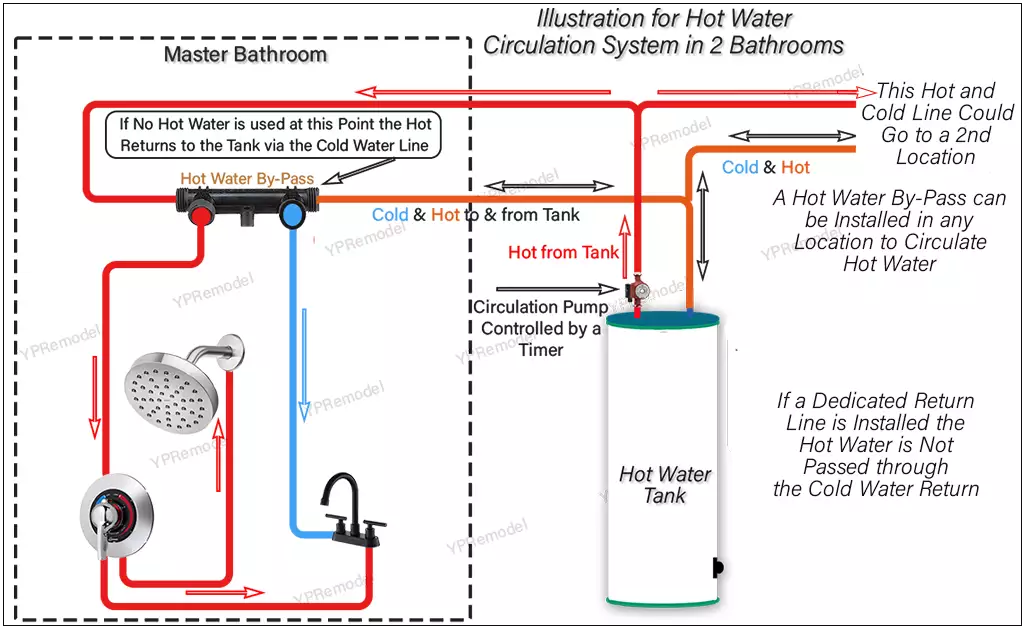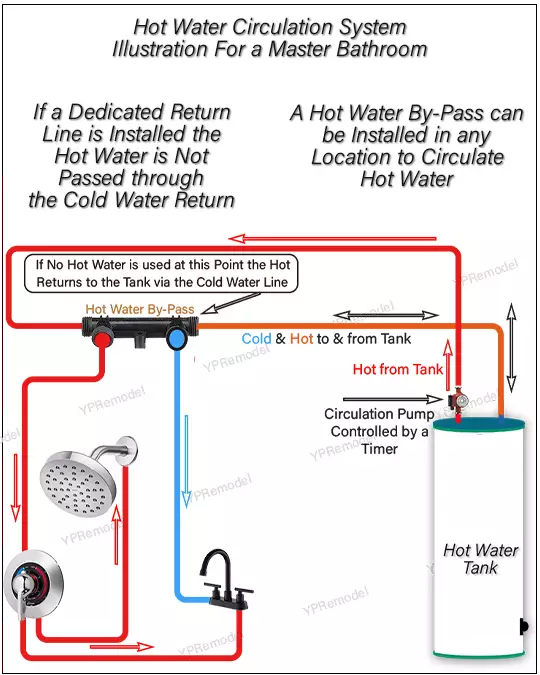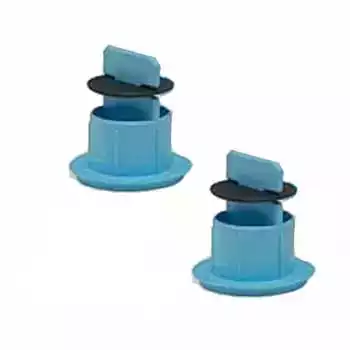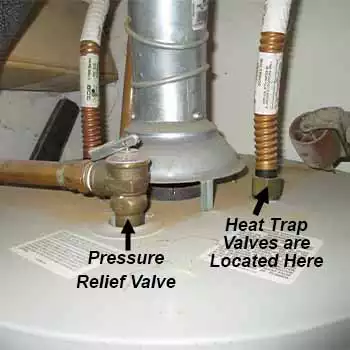

The Components
The 2 Main Components of A Hot Water Circulation System are the Circulation Pump and the Water Valve. The Circulation Pump Pushes Hot Water from the Tank to the Water Vale. The Water Valve is typically mounted under a Sink Farthest from the Tank. You can easily have 2 Locations for Valves if needed but be sure the Circulation Pump can handle the extra Volume.
The most Common location for the Circ Pump is directly on the Hot Water Tank. Alternatively you could have the Circ Pump under 1 or more Sinks. In either location you will need a Power Source for the Pump and Timer. The Timer allows you to set the Time so the Pump Operates only when needed. Some Pumps have a Timer Built in. Note: The Timer could go bad before the Pump so be sure it is a Common Replaceable Timer.
Hot Water Bypass Assembly
The Water Valve is a Simple Plumbing Devise that allows the Hot Water From the Tank to pass to its Location and Return to the Tank. The Water will be Hot or at least Hotter at that Faucet When the Circ Pump is in Operation.
This System is Designed to use the Cold Water Line to complete the Loop from the Tank and Back. That would be the downside to this Type of Circulation System. Some say after a Shower you have to wait for the Water at the Sink to get Cold and that is also wasting Water.
In Theory the wait for Cold or Cooler Water could be much less considering warm would be OK for a short time. If you consider how much Water is going down the Drain while waiting for Hot Water to Arrive for a Shower, it could be a Fair Trade off.(see Waste Water Caculations at the End)
An Alternative to Bypass Assembly
There is an Alternative, have a Dedicated Return Line back to the Tank. In a New Build it would be Simple to add a line. It is not impossible in an Existing Home to have a Dedicated Line Returning.
Dedicated Return Lines in most cases should be insulated for Efficiency, in fact All the Water Lines, if passing through a Cold Attic or Basement should be Insulated.
Heat Traps
Heat Traps in your Water Tank may take the Simplicity out of this Pro or DIY Project. Most if not All newer Hot Water Tanks have Heat Traps installed in Pipe Nipples for the Cold Inlet and the Hot Outlet at the top of the Tank.
Heat Traps Prevent the Heat inside the Tank from Escaping by Convection or Thermo Siphoning Heat Exchange sometimes referred to as Thermal Expansion.
Heat Traps are a Simple Check Valve, They could be a Flap or a Ball in Socket both Designs only allow Flow in 1 Direction. Returning to the Tank is the problem, if you can't get Water Back in the Tank, the Recirculation Pump will not function properly.
Some say the Heat Traps only reduce the Flow needed by the Hot Water Circulation Pumps. The flow restriction could be enough to allow the Hot Water to be cooled in the time it takes to reach the Sink or Shower. The result is only Warm Water instead of Hot Water.
Some Water Circulation System Manufactures state they will not work on Hot Water Tanks with Heat Traps.
Some just remove the Flap or Ball inside the Pipe Nipple or remove the Pipe Nipple from the Tank. I agree, the Heat Traps should be removed. The Pipe Nipples are installed at the Factory and could be difficult to remove and Disassembling the Check Valve parts could also be challenging.
Heat Trap Example

Heat Traps Location

As you can see in the Picture above, it looks like No Heat Traps. The Sticker on top of the Tank indicates there are Heat Traps installed.
Pro or DIY this Project should be quite simple except for the Heat Traps. If anyone can add something you gained from experience please let us know. We will Not Post your Information.
Using a Hot Water Circulation System with a Tankless Water Heater will require enough Flow to Activate the Heater. Some don't recommend it. Hot Water Circulation Systems work fine with a Tankless Water Heaters, just check the Flow Rate of the Pump and the Flow Rate Required to Activate the Tankless Water Heater. I have an Example in The Article on Tankless Water Heaters. See Link below
Water Waste Calculations
Do you have any Idea How much Water goes down the Drain just to get the Water in the Shower Hot enough to use? Since 1992 the Federally Mandated Maximum Flow for the Shower Head is 2.5 Gallons per Minute. Prior to that date the Flow Rate was about 3.5 Gallons per Minute. Some Re-designed Shower Heads like the Hand Held Massage Type may be less than 2.5 GPM.
If you waited 1 minute for Hot water it is only 2 1/2 Gallons, but if you had the Shower going for 5 Minutes now you have wasted 12 1/2 Gallons not to mention the Energy used to Heat the Water plus your time.
So 12 1/2 Gallons per person 7 days a week is 87 1/2 Gallons or 350 Gallons per Month per Person.
Then the 15 minute shower makes it a total of 1500 Gallons per person per month. So to save that first 350 gallons each month a Hot Water Circulation System seems like the Perfect Solution.
Comment Below
Internal Links
Like this Article, you can give us a Thumbs just click on the Icon. It's anonymous and we will Thank You.

“Lost time is never found again”
Ben Franklin
© Copyright 2023 YPRemodel.com. All rights Reserved. This material may not be Published, Broadcast, Rewritten or Redistributed without written Permission.
